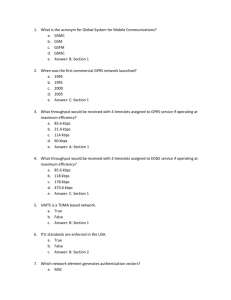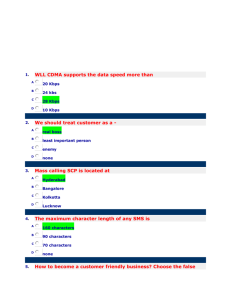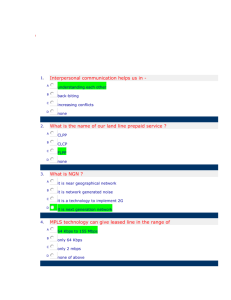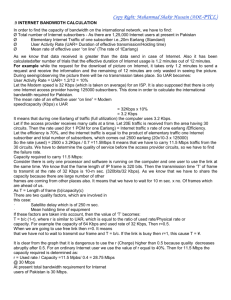Document
advertisement
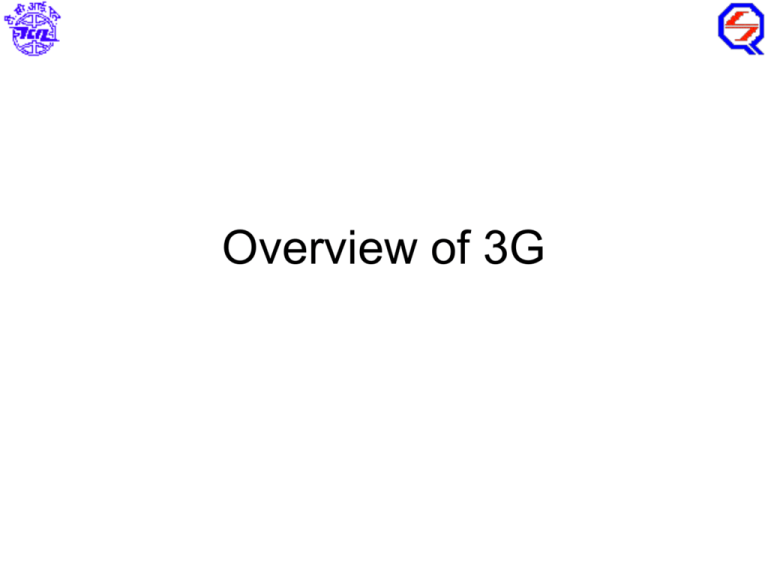
Overview of 3G Why 3G? • Higher bandwidth enables a range of new applications!! • For the consumer – Video streaming, TV broadcast – Video calls, video clips – news, music, sports – Enhanced gaming, chat, location services… • For business – High speed teleworking / VPN access – Sales force automation – Video conferencing – Real-time financial information 2 3G services in Asia • CDMA (1xEV-DO) – Korea: SKT, KTF – Japan: AU (KDDI) • WCDMA / UMTS – Japan: NTT DoCoMo, Vodafone KK – Australia: 3 Hutchinson – Hong Kong: 3 Hutchinson 3 3G Standards • 3G Standard is created by ITU-T and is called as IMT-2000. • The aim of IMT-2000 is to harmonize worldwide 3G systems to provide Global Roaming. 4 Upgrade paths for 2G Technologies 2G 2.5G IS-95 GSM- GPRS IS-95B HSCSD Cdma2000-1xRTT 3G IS-136 & PDC EDGE W-CDMA EDGE Cdma2000-1xEV,DV,DO TD-SCDMA Cdma2000-3xRTT 3GPP2 3GPP 5 Evolution of Mobile Systems to 3G - drivers are capacity, data speeds, lower cost of delivery for revenue growth Expected market share TDMA GSM EDGE GPRS 2G 3GPP Core Network WCDMA PDC cdmaOne EDGE Evolution CDMA2000 1x First Step into 3G 90% HSDPA CDMA2000 1x EV/DV 10% CDMA2000 1x EV/DO 3G phase 1 Evolved 3G 6 Performance evolution of cellular technologies 7 Services roadmap Improved performance, decreasing cost of delivery Broadband in wide area 3G-specific services take advantage of higher bandwidth and/or real-time QoS Video sharing Video telephony Real-time IP A number of mobile Multitasking multimedia and games services are bearer WEB browsing Multicasting independent in nature Corporate data access Streaming audio/video MMS picture / video xHTML browsing Application downloading E-mail Presence/location Voice & SMS Push-to-talk EGPRS 473 kbps WCDMA 2 Mbps HSDPA 1-10 Mbps CDMA 2000EVDV GPRS 171 kbps CDMA 2000EVDO GSM 9.6 kbps CDMA 2000 1x Typical average bit rates (peak rates higher) 8 2G TECHNOLOGIES CdmaOne, IS-95 GSM, DCS-1900 Uplink Frequencies 824-849 MHz (US Cellular) 1850-1910 MHz (US PCS) 890-915 MHz (Europe) 1850-1910 MHz (US PCS) 800 MHz, 1500 MHz (Japan) 1850-1910 MHz (US PCS) Downlink Frequencies 869-894 MHz (US Cellular) 1930-1990 MHz (US PCS) 935-960 MHz (Europe) 1930-1990 MHz (US PCS) 824-849 MHz (US Cellular) 1930-1990 MHz (US PCS) 800 MHz, 1500 MHz (Japan) FDD FDD FDD CDMA TDMA TDMA Modulation BPSK with Quadrature Spreading GMSK with BT=0.3 /4 DQPSK Carrier Separation 1.25 MHz 200 KHz 30 KHz (IS-136) (25 KHz for PDC) Channel Data Rate 1.2288 Mchips/sec 260.833 Kbps 48.6 Kbps (IS-136) (25 KHz for PDC) Voice Channels per carrier 64 8 3 CELP @ 13 Kbps, EVRC @ 8 Kbps RPE-LTP @ 13 Kbps VSELP @ 7.95 Kbps Duplexing Multiple Access Tech. Speech Coding IS-54/IS-136, PDC 9 GSM evolution to 3G High Speed Circuit Switched Data Dedicate up to 4 timeslots for data connection ~ 50 kbps Good for real-time applications c.w. GPRS Inefficient -> ties up resources, even when nothing sent Not as popular as GPRS (many skipping HSCSD) GSM 9.6kbps (one timeslot) GSM Data Also called CSD GSM HSCSD Enhanced Data Rates for Global Evolution Uses 8PSK modulation 3x improvement in data rate on short distances Can fall back to GMSK for greater distances Combine with GPRS (EGPRS) ~ 384 kbps Can also be combined with HSCSD GPRS General Packet Radio Services Data rates up to ~ 115 kbps Max: 8 timeslots used as any one time Packet switched; resources not tied up all the time Contention based. Efficient, but variable delays GSM / GPRS core network re-used by WCDMA (3G) WCDMA EDGE 10 GPRS • General Packet Radio Service – Packet based Data Network – Well suited for non-real time internet usage including retrieval of email, faxes and asymmetric web browsing. – Supports multi user network sharing of individual radio channels and time slots. – Provides packet network on dedicated GSM radio channels – GPRS overlays a packet-switched architecture on existing GSM network architecture • Variable performance… – – – – Packet Random Access, Packet Switched Content handling Throughput depends on coding scheme, # timeslots etc From ~ 9 kbps min to max. of 171.8 kbps (in theory!) 11 GPRS (contd..) • • • • • • • Modulation – GMSK Symbol Rate – 270 ksym/s Modulation bit rate – 270 kbps Radio data rate per time slot – 22.8kbps User data rate per time slot – 20kbps (CS4) User data rate (8 time slots) – 160kbps, 182.4kbps Applications are required to provide their own error correction scheme as part of carried data payload. 12 Max throughput per GPRS channel (netto bitrate, kbit/sec) Channel data rates determined by Coding Scheme Use higher coding schemes (less coding, more payload) when radio conditions are good 20 CS 4 16 CS 3 12 CS 2 8 CS 1 4 0 27dB 23dB 19dB 15dB 11dB 7dB C/I 3dB CS1 guarantees connectivity under all conditions (signaling and start of data) CS2 enhances the capacity and may be utilised during the data transfer phase CS3/CS4 will bring the highest speed but only under good conditions 13 EDGE • EDGE Enhanced Data Rates for Global Evolution – – – – – – – – – – – EDGE is add-on to GPRS Uses 8-PSK modulation in good conditions Increase throughput by 3x (8-PSK – 3 bits/symbol vs GMSK 1 bit/symbol) Offer data rates of 384kbps, theoretically up to 473.6kbps Uses 9 Modulation coding schemes (MCS1-9) MCS(1-4) uses GMSK, while MCS(5-9) uses 8PSK modulation. Uses Link adaptation algorithm Modulation Bit rate – 810kbps Radio data rate per time slot – 69.2kbps User data rate per time slot – 59.2kbps (MCS9) User data rate (8 time slots) – 473.6kbps • New handsets / terminal equipment; additional hardware in the BTS, Core network and the rest remains the same • EDGE access develops to connect to 3G core 14 Coding Schemes for EGPRS 15 UMTS • UMTS is the European vision of 3G. • UMTS is an upgrade from GSM via GPRS or EDGE. • The standardization work for UMTS is carried out by Third Generation Partnership Project (3GPP). • Data rates of UMTS are: – 144 kbps for rural – 384 kbps for urban outdoor – 2048 kbps for indoor and low range outdoor • Virtual Home Environment (VHE) 16 UMTS Network Architecture Mobile Station ME SIM Base Station Subsystem BTS BSC Network Subsystem MSC/ VLR EIR Other Networks GMSC PSTN HLR AUC PLMN RNS ME USIM SD + Node B RNC SGSN GGSN Internet UTRAN Note: Interfaces have been omitted for clarity purposes. 17 UMTS Network Architecture • UMTS network architecture consists of three domains: – Core Network (CN) : To provide switching, routing and transit for user traffic. – UMTS Terrestrial Radio Access Network (UTRAN) : Provides the air interface access method for User Equipment. – User Equipment (UE) : Terminals work as air interface counterpart for Node B. The various identities are: IMSI, TMSI, P-TMSI, TLLI, MSISDN, IMEI, IMEISV. 18 UTRAN • Wide band CDMA technology is selected for UTRAN air interface. • Base Station is referred to as Node-B and control equipment for Node-B’s is called is called as Radio Network Controller (RNC). – Functions of Node –B are: • Air Interface Tx/Rx • Modulation / Demodulation – Functions of RNC are: • Radio Resource Control • Channel Allocation • Power Control Settings • Handover Control • Ciphering • Segmentation and Reassembly 19 UMTS Frequency Spectrum • UMTS Band : 1900-2025 MHz and 2110-2200 MHz for 3G transmission. • Terrestrial UMTS (UTRAN) : 1900-1980 MHz, 2010-2025 MHz, and 21102170 MHz bands 20 IMPACT ON EXISTING NETWORK Wireless Data Tech HSCSD GPRS EDGE W-CDMA Channel BW 200KHz 200KHz 200KHz 5MHz Duplex Infrastructure Change FDD Requires Software Upgrade at base station FDD Requires new packet overlay including routers and gateways FDD Requires new transceivers at base station. Also, software upgrade to the BSC & BTS FDD Requires completely new base stations Requires New Spectrum Requires New Handsets No Yes, New HSCSD handsets provide 57.6Kbps on HSCSD n/w and 9.6 Kbps on GSM n/w with dual mode phones. GSM only phones will not work in HSCSD N/w. No Yes, New GPRS handsets work on GPRS n/w at 171.2Kbps, 9.6 Kbps on GSM n/w with dual mode phones. GSM only phones will not work in GPRS n/w. No Yes, New handsets work on EDGE n/w at 384Kbps, GPRS n/w at 144Kbps, and GSM n/w at 9.6 Kbps with tri-mode phones. GSM and GPRS-only phones will not work in EDGE n/w. Yes Yes, New W-CDMA handsets will work on W-CDMA at 2Mbps, EDGE n/w at 384 Kbps, GPRS n/w at 144 Kbps. GSM n/w at 9.9 Kbps. Older handsets will not 21 work in W-CDMA. WCDMA – 25 device suppliers Amoi NEC Sharp BenQ Nokia Siemens Fujitsu Novatel Wireless Sierra Wireless Hisense Sony Ericsson HTC NTT DoCoMo (Raku Raku) Toshiba Huawei LG Mitsubishi Motorola Panasonic Pantech Samsung Sanyo Seiko Vodafone (Option Wireless PC card) ZTE 22 Combined WCDMA-EDGE networks At least 40 operators are delivering 3G services on combined WCDMA-EDGE networks. WCDMA and EDGE are comple-mentary technologies ensuring lower capital cost, optimum flexibility and efficiencies AIS, Thailand Ålands Mobiltelefon, Finland Batelco, Bahrain Cellcom, Israel Cingular Wireless, USA CSL, Hong Kong Dialog GSM, Sri Lanka Elisa, Finland EMT, Estonia Eurotel Praha, Czech Eurotel Bratislava, Slovak GPTC, Libya Maxis, Malaysia Mobilkom Austria Mobitel, Bulgaria Mobily, Saudia Arabia MTC Vodafone, Bahrain MTN, South Africa Netcom, Norway Orange, France Orange, Romania Orange Slovensko, Slovak Oskar Mobile, Czech Pannon GSM, Hungary Polkomtel, Poland Rogers Wireless - Fido, Canada Si. Mobil – Vodafone, Slovenia Swisscom, Switzerland Telenor, Norway T-Mobile, Croatia T-Mobile, Czech T-Mobile, Hungary T-Mobile, USA Telfort, Netherlands TeliaSonera, Denmark TeliaSonera, Finland TeliaSonera, Sweden TIM Hellas, Greece TIM, Italy VIP Net, Croatia 23 W-CDMA makes possible a world of mobile multimedia 24 CDMA2000 evolution to 3G IS-95B Uses multiple code channels Data rates up to 64kbps Many operators gone direct to 1xRTT IS-95B CDMA IS-95A IS-95A 14.4 kbps Core network re-used in CDMA2000 CDMA2000 1xEV-DO: Evolved Data Optimised Third phase in CDMA2000 evolution Standardised version of Qualcomm High Data Rate (HDR) Adds TDMA components beneath code components Good for highly asymmetric high speed data apps Speeds to 2Mbps +, classed as a “3G” system Use new or existing spectrum 1xEV-DO 1xRTT CDMA2000 1xRTT: single carrier RTT First phase in CDMA2000 evolution Easy co-existence with IS-95A air interface Release 0 - max 144 kbps Release A – max 384 kbps Same core network as IS-95 1xEV-DV CDMA2000 3xRTT CDMA2000 1x Evolved DV Fourth phase in CDMA2000 evolution Still under development Speeds to 5Mbps+ (more than 3xRTT!) Possible end game. 25 IS-95A CDMA was commercially introduced in 1995 with IS-95A or cdmaOne. IS-95A is the CDMA-based second generation (2G) standard for mobile communication. The following are the key aspects of this standard: • Support for data rates of upto 14.4 kbps • IS-95A has been used exclusively for circuit-switched voice • Convolutional Channel coding used • Modulation technique used is BPSK 26 IS-95B IS-95B or cdmaOne is the evolved version of IS-95A and is designated as 2.5G. IS-95B maintains the Physical Layer of IS-95A, but due to an enhanced MAC layer, is capable of providing for higher speed data services. The following are the key aspects of the standard: • Theoretical data rates of upto 115 kbps, with generally experienced rates of 64 kbps • Additional Walsh codes and PN sequence masks, which enable a mobile user to be assigned up to eight forward or reverse code channels simultaneously, thus enabling a higher data rate • Code channels, which are transmitted at full data rates during a data burst • Convolutional Channel coding • Binary Phase Shift Keying (BPSK) as the Modulation technique used 27 CDMA 2000 1X •Supports theoretical data rates of upto 307 kbps, with generally experienced rates of 144 kbps • The newly introduced Q-PCH of CDMA 2000 enables the mobile to be informed about when it needs to monitor F-CCCH and the Paging Channel, thus improving on the battery life • Introduction of Radio Configurations – Transmission formats characterized by physical layer parameters such as data rates, modulation characteristics, and spreading rate. RCs help in providing for additional data rates. • Quality and Erasure indicator bits (QIB and EIB) on the reverse power control sub channel. These help in indicating to the BS about bad frames or lost frames received at the mobile station, so that they can be retransmitted • Code channels are transmitted at full data rates during a data burst • Convolutional and Turbo coding techniques used • Modulation technique used is QPSK 28 CDMA 2000 3X • Offering data speeds up to 2 Mbps • Using three standard 1.25 MHz channels within a 5 MHz band • Leveraging deployment experiences, and manufacturers’ learning curves of today’s widely adopted, commercially available CDMA systems • Using Convolutional and Turbo coding techniques • Using QPSK as the Modulation technique 29 1X EV-DO • Supporting data rates of up to 2.4 Mbps • Having no backward-compatibility with CDMA 2000 • Including two inter-operable modes: an integrated 1x mode optimized for voice and medium data speeds, and a 1xEV mode optimized for non real-time high capacity/high speed data and Internet access • Providing Adaptive Rate Operation with respect to channel conditions • Providing Adaptive modulation and coding • Providing Macro diversity via radio selection • Providing an always-on operation of 1xEV-DO terminals in the active state • Using a multi-level modulation format (QPSK, 8-PSK, 16-QAM) 30 1xEV-DV • Backward compatible with CDMA 2000. • EV-DV can be easily extended to operate in 3x mode under the framework of current system. • Forward peak data rate : 3.072 Mbps. • Reverse peak data rate: 451.2 kbps. • Addition of three new channels to f/w link and reverse link for packet data operation and its support. • Adaptive modulation and coding : QPSK, 8- PSK, 16-QAM • Variable frame duration • Mobile station can select one of N base stations. • DTX transmission supported for saving battery life. 31 1xEV-DV and UMTS Comparison 32 IMPACT ON EXISTING NETWORK Wireless Channel Duplex Data Tech. BW IS-95B 1.25MHz Cdma2000 1.25MHz 1xRTT Cdma2000 1.25MHz 1xEV (DO & DV) Cdma2000 3.75MHz 3xRTT Infrastructure Change FDD Requires new software in BSC FDD Requires new s/w in backbone and new channel cards at base stations. Also need to build a new packet service node. FDD Requires s/w and digital card upgrade on 1xRTT networks FDD Requires backbone modifications and new channel cards at base stations. Requires New Spectrum Requires New Handsets No Yes, New handsets will work on IS-95B at 64 Kbps and IS-95A at 14.4 Kbps. Cdma One phones can work in IS-95B at 14.4 Kbps No Yes, New handsets will work on 1xRTT at 144 Kbps, IS-95B at 64 Kbps, IS-95A at 14.4 Kbps. Older handsets can work in 1xRTT but at lower speeds. No Yes,New handsets can work on 1xEV at 2.4 Mbps, 1xRTT at 144 Kbps, IS95B at 64 Kbps, IS-95A at 14.4 Kbps. Older handsets can work in 1xEV but at lower speeds. Maybe Yes, New handsets will work on 95A at 14.4 Kbps, 95B at 64 Kbps, 1xRTT at 144 Kbps, 3xRTT at 2 Mbps. Older handsets can work in 3X but at lower speeds. 33 34 CDMA2000 1X and CDMA 1X EVDO Vendors Terminal Vendors • Audiovox • Ericsson • Hyundai CURITEL • Kyocera • LG Electronics • Motorola • Nokia • Samsung • Sanyo • SK TeleTech Wireless Modem • AirPrime • AnyDATA • GTRAN • Novatel Wireless • Sierra Wireless 35 Adoption of different mobile standards First steps to 3G 270 commercial GPRS networks 141 networks deploying GPRS/EDGE 84 commercial EDGE networks (source: GSA, May 16, 2005) 121 commercial Cdma2000 1x networks (source: CDG, May 13, 2005) No. of commercial networks per mobile data standard 300 250 200 150 100 50 3G 0 EDGE/GPRS CDMA2000-1x WCDMA 1xEV-DO WCDMA: 134 licenses awarded 71 commercial WCDMA networks (source: GSAMay 12, 2005) 22 commercial CDMA 1x EV-DO networks (source: CDG, May 13, 2005) Evolved 3G HSDPA: all WCDMA operators expected to upgrade to HSDPA (SW upgrade to BTS) CDMA 1x EV-DV: limited industry support 36 3G Network Vendors: Groups and JV 1. ALCATEL + FUJITSU (Alcatel hold 66 percent of the shares of the Evolium SAS, and Fujitsu holds the rest) 2. SIEMENS + NEC (Mobisphere Ltd.,) + CASIO / TOSHIBA 3. MOTOROLA + CISCO + FIJITSU + PIONEER + ALCATEL (Alcatel RNC, MOTOROLA Node B) 4. SAGEM + FUJITSU (Handset) 6. NOKIA + CISCO (IP Core network), 7. NOKIA + Interdigital (technology development relationship) 8. NORTEL + Matsushita/Panasonic + SAMSUNG 9. LUCENT (alone) 10.ERICSSON (alone) 11.CISCO+KPMG Cisco routeurs, KPMG consulting 37 3.5G 3.5G or HSDPA (High Speed Downlink Packet Access) is an enhanced version and the next intermediate generation of 3G UMTS. It comprises the technologies that improve the Air Interface and increase the spectral efficiency, to support data rates of the order of 30 Mbps. 3.5G introduces many new features that will enhance the UMTS technology in future. 1xEV-DV already supports most of the features that will be provided in 3.5G. These include: • Adaptive Modulation and Coding • Fast Scheduling • Backward compatibility with 3G • Enhanced Air interface 38 4G: Anytime, Anywhere Connection • Also known as ‘Mobile Broadband everywhere’ • ‘MAGIC’ – Mobile Multimedia Communication – Anywhere, Anytime with Anyone – Global Mobility Support – Integrated Wireless Solution – Customized Personal Service • According to 4G Mobile Forum, by 2008 over $400 billion would be invested in 4G mobile projects. • In India, communication Minister Mr. Dayanidhi Maran, has announced a national centre of excellence to work in 4G arena. 39 4G: Data rate Facts • Transmission at 20 Mbps • 2000 times faster than mobile data rates • 10 times faster than top transmission rates planned in final build out of 3G broadband mobile • 10-20 times faster than standard ADSL services. • Companies developing 4G technology – Cellular phone companies: Alcatel, Nortel, Motorola, – IT Companies: Hughes,HP,LG Electronics 40 Thanks
